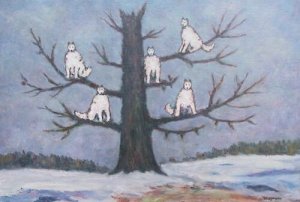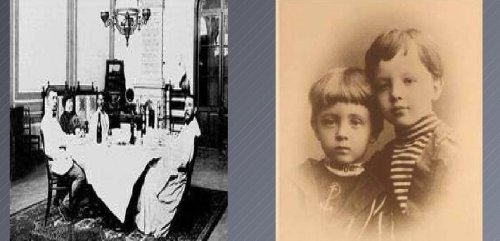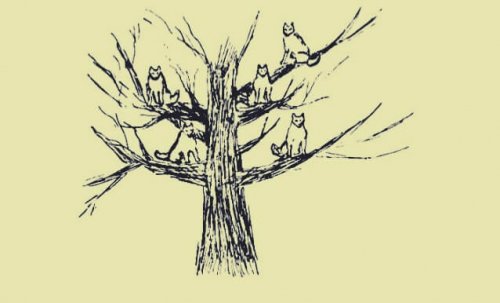The Wolf Man: A Paradigmatic Case of Psychoanalysis

The case of Sergei Konstantinovich Pankejeff made history under the name “Wolf Man”. His story appeared in a book by Sigmund Freud titled From the History of an Infantile Neurosis. Freud used Pankejeff’s story to support many of his theories. Consequently, his case is one of the most paradigmatic in the field of psychoanalysis.
Sergei Pankejeff, otherwise known as Wolf Man, knocked on Freud’s door at the age of 23 and was Freud’s patient from 1910-1914. Pankejeff was from Russia and was the son of a mother who was extremely worried about his physical health. He suffered from alternating periods of hyperactivity and depression.
One of his paternal uncles suffered from paranoia and lived among animals. Another caused a big scandal when he tried to force his son’s boyfriend to marry him instead. One of Pankejeff’s cousins also suffered from persecution delusions. In short, Pankejeff was surrounded by a lot of emotional instability.
The History of the Wolf Man
When the Wolf Man was 15 years old, his only sister who was two years older than him committed suicide. A year before her death, he already showed signs of serious depression. A few years later, Sergei’s father also took his own life.
When he was about 17 years old, an encounter with a prostitute left him with gonorrhea. Since then, he suffered from several depressive episodes. His family admitted him to different clinics hoping that he’d get better. The doctors diagnosed him with manic-depressive disorder.
At the same time, he developed some serious health problems. He suffered from chronic constipation and a chronic gastrointestinal disorder. He was very weak when he arrived at Freud’s clinic. From the very beginning, he was inscrutable and secretive. It seemed like he didn’t care about his treatment, although he followed all of Freud’s instructions.
In an attempt to get through to his patient, Freud decided to tell Pankejeff that his treatment was going to end. The two had already formed a bond and Freud’s threat was enough to break through his patient’s walls. The Wolf Man finally committed fully to the analysis and started to share interesting things at his sessions. That made it possible for Freud to elaborate on his case.

The Wolf Man
Freud labeled Pankejeff as “Wolf Man” due to a dream about wolves that he shared with his psychoanalyst. Freud believes that this dream helped him begin to explain Sergei’s unconscious. Although the patient had the dream when he was about four years old, it had left a very strong impression on him.
In the dream, Sergei watched his bedroom window open by itself. It was winter. On the branches of a huge walnut tree were six or seven completely white wolves. They had huge wolf-like tails and their ears pointed straight up like dogs. They were still and watched Sergei closely. Four-year-old Sergei was terrified and woke up crying. He felt like the dream was real. Adult Sergei drew his dream for Freud.
In psychoanalysis, dreams are like hieroglyphs that you have to decode. The elements that appear in the dreams are symbolic. You can establish their meaning based on the subject’s real-life experiences. This is exactly what Freud did with the Wolf Man.

Infantile Neurosis
Once Freud heard about Pankejeff’s dream, he began exploring experiences from his childhood. He discovered that when he was a year and a half, he saw his parents having sex. From that, Freud designed the concept of the “primal scene”. He also discovered that the Wolf Man had some childhood sexual experiences with his sister. He also tried and failed to seduce his babysitter.
Freud also discovered that Pankejeff was obsessed with religion. He prayed for several hours a day and kissed the figures of saints before going to bed. Nevertheless, he couldn’t avoid feeling guilty about what he had done and what he believed.

After fleshing out all of these experiences in detail, Freud concluded that the Wolf Man had a case of repressed homosexuality. Freud deemed Sergei Pankejeff “cured” after his treatment with psychoanalysis.
However, after World War I, Pankejeff sought help from another psychoanalyst. Later, he wrote an autobiography that said he had made up the dream about the wolves. Whether he did or not, his case has been reinterpreted hundreds of times and is still quite controversial today.
The case of Sergei Konstantinovich Pankejeff made history under the name “Wolf Man”. His story appeared in a book by Sigmund Freud titled From the History of an Infantile Neurosis. Freud used Pankejeff’s story to support many of his theories. Consequently, his case is one of the most paradigmatic in the field of psychoanalysis.
Sergei Pankejeff, otherwise known as Wolf Man, knocked on Freud’s door at the age of 23 and was Freud’s patient from 1910-1914. Pankejeff was from Russia and was the son of a mother who was extremely worried about his physical health. He suffered from alternating periods of hyperactivity and depression.
One of his paternal uncles suffered from paranoia and lived among animals. Another caused a big scandal when he tried to force his son’s boyfriend to marry him instead. One of Pankejeff’s cousins also suffered from persecution delusions. In short, Pankejeff was surrounded by a lot of emotional instability.
The History of the Wolf Man
When the Wolf Man was 15 years old, his only sister who was two years older than him committed suicide. A year before her death, he already showed signs of serious depression. A few years later, Sergei’s father also took his own life.
When he was about 17 years old, an encounter with a prostitute left him with gonorrhea. Since then, he suffered from several depressive episodes. His family admitted him to different clinics hoping that he’d get better. The doctors diagnosed him with manic-depressive disorder.
At the same time, he developed some serious health problems. He suffered from chronic constipation and a chronic gastrointestinal disorder. He was very weak when he arrived at Freud’s clinic. From the very beginning, he was inscrutable and secretive. It seemed like he didn’t care about his treatment, although he followed all of Freud’s instructions.
In an attempt to get through to his patient, Freud decided to tell Pankejeff that his treatment was going to end. The two had already formed a bond and Freud’s threat was enough to break through his patient’s walls. The Wolf Man finally committed fully to the analysis and started to share interesting things at his sessions. That made it possible for Freud to elaborate on his case.

The Wolf Man
Freud labeled Pankejeff as “Wolf Man” due to a dream about wolves that he shared with his psychoanalyst. Freud believes that this dream helped him begin to explain Sergei’s unconscious. Although the patient had the dream when he was about four years old, it had left a very strong impression on him.
In the dream, Sergei watched his bedroom window open by itself. It was winter. On the branches of a huge walnut tree were six or seven completely white wolves. They had huge wolf-like tails and their ears pointed straight up like dogs. They were still and watched Sergei closely. Four-year-old Sergei was terrified and woke up crying. He felt like the dream was real. Adult Sergei drew his dream for Freud.
In psychoanalysis, dreams are like hieroglyphs that you have to decode. The elements that appear in the dreams are symbolic. You can establish their meaning based on the subject’s real-life experiences. This is exactly what Freud did with the Wolf Man.

Infantile Neurosis
Once Freud heard about Pankejeff’s dream, he began exploring experiences from his childhood. He discovered that when he was a year and a half, he saw his parents having sex. From that, Freud designed the concept of the “primal scene”. He also discovered that the Wolf Man had some childhood sexual experiences with his sister. He also tried and failed to seduce his babysitter.
Freud also discovered that Pankejeff was obsessed with religion. He prayed for several hours a day and kissed the figures of saints before going to bed. Nevertheless, he couldn’t avoid feeling guilty about what he had done and what he believed.

After fleshing out all of these experiences in detail, Freud concluded that the Wolf Man had a case of repressed homosexuality. Freud deemed Sergei Pankejeff “cured” after his treatment with psychoanalysis.
However, after World War I, Pankejeff sought help from another psychoanalyst. Later, he wrote an autobiography that said he had made up the dream about the wolves. Whether he did or not, his case has been reinterpreted hundreds of times and is still quite controversial today.
This text is provided for informational purposes only and does not replace consultation with a professional. If in doubt, consult your specialist.







